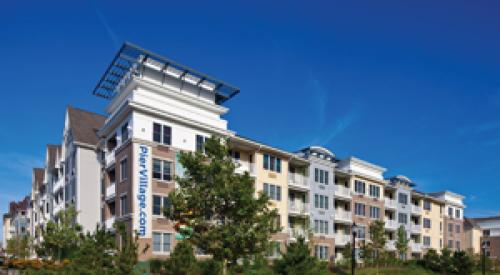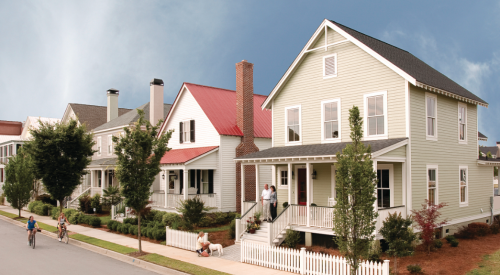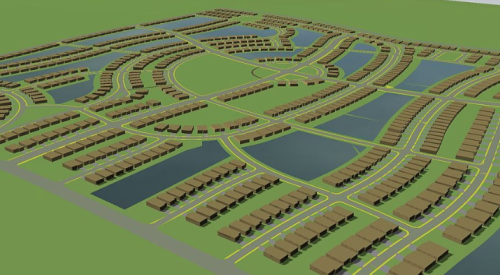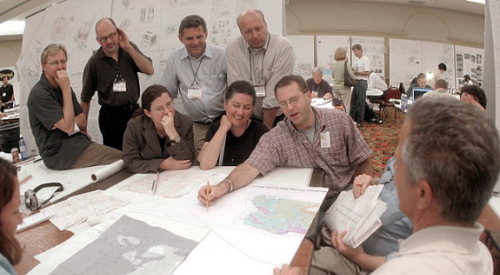|
Wherever you go in America, strip malls are part of the landscape. That is the beauty of Randy Jackson’s proposed housing solution for land-strapped Orange County, Calif. If it works there, it probably will work in many other places.
Early last year, Jackson, president of The Planning Center, a land-planning and environmental consulting firm in Costa Mesa, Calif., did the legwork to test a hunch. His idea: Fast-growing Orange County would have space for the “next million residents” if “underutilized” strip malls were altered to allow housing.
Jackson points out that in a typical small strip mall with a dry cleaner, a pharmacy and two fast-food restaurants surrounded by asphalt, less than 20% of the parcel is built out; the rest is underused blacktop. He envisions elevated parking with homes and apartments above. Eventually, he says, the updated mall would be more walkable, like a “suburban village” with retailers benefiting from the patronage of nearby residents.
“The goal is to turn it from a conventional shopping center into something where you would create a new walking street,” says Jackson. “It is a much more intensive use, and you get the residential stock, the nightlife and the people back into the community.”
Jackson calls Orange County a victim of its own success. It is a desirable place to work and live, but with job creation outpacing home creation, a housing affordability crisis is set to get only worse. Also, Orange County is home to a massive grid of arterial streets where strip malls have flourished beyond the area’s ability to sustain them. Many of the older ones have high vacancies and have degraded in appearance.
| “Builders soon realize that it is not always the best idea to continually go outside our communities to look for land.” |
Until Jackson and his team came along, nobody had quantified the problem of too many strip malls or the huge opportunity. Nor had anyone studied individual sites to see if the numbers would work and if they would be politically viable for government officials to back.
By analyzing geographical information systems and census and tax-roll data on computers as well as by driving the streets of Santa Ana, Garden Grove and other Orange County cities, Jackson and his team identified more than 700 parcels as ripe for redevelopment. After a lengthy story about the idea ran in the Los Angeles Times, residential developers and local planners across Southern California called The Planning Center in droves, says Jackson.
“The interesting thing is that everybody who hears about the concept on both sides of the fence — environmentalists, builders, cities, entrepreneurs — all see the logic.”
The response from builders such as Brookfield Homes, Lennar and Western Pacific Homes also has been strong, he says. They want to understand the fundamentals, Jackson explains, and some are working to strike deals with mall owners and city officials.
But every site is different, so the solutions will vary greatly. “Each builder and each city has its own set of priorities,” Jackson says.
Ranging from a half-acre to 20 acres, the 700-plus parcels would otherwise be overlooked in regional planning efforts. Since June, when the article about Jackson’s “suburban village” concept appeared, Santa Ana planners have analyzed the western portion of their city and found a 40% excess in retail strip centers versus the number of “trips” needed to sustain them.
Projects based on Jackson’s work are quickly moving forward. In Anaheim, The Planning Center is working with the city to redevelop a site with a Safeway food store, a Sav-on pharmacy, a Jack in the Box restaurant and about 35,000 square feet of miscellaneous retail space. Unusually, Sav-on and Safeway own their properties and the parking rights, and both are happy.
“So you can’t just blast them out of there,” Jackson says. “What we will do is deck the parking and leave their space intact on the ground level, and on the second level build either apartments or free-standing homes. We will also strip the ground floor with some additional shops for a little main street.”
Jackson’s vision for adding affordable housing is catching fire in Southern California for a number of reasons. Here are the top three:
- Costly environmental impact reports are only a formality in urbanized areas, saving developers consulting costs and reducing the usual approval delay.
- Orange County cities realize that jobs eventually will go where the homes are and thus are open to all ideas about adding low-cost housing.
- Cities are also encouraged about the potential addition of taxable parcels.
There are obstacles as well. In upscale communities such as Irvine and Newport Beach, strip conversions are not politically viable, Jackson says, because of resistance to affordable, high-density housing. Also, a town-by-town zoning revision is often required, which means a time-consuming education process, he says. But Jackson’s rigorous, parcel-by-parcel analysis of strip centers is a model that others are quickly following.
“I think you almost come to an epiphany,” Jackson says about the relentless search for buildable land. “There is so much of this land available, and once the veil is lifted, builders soon realize that it is not always the best idea to beat ourselves to death by continually going outside of our communities to look for land.”












